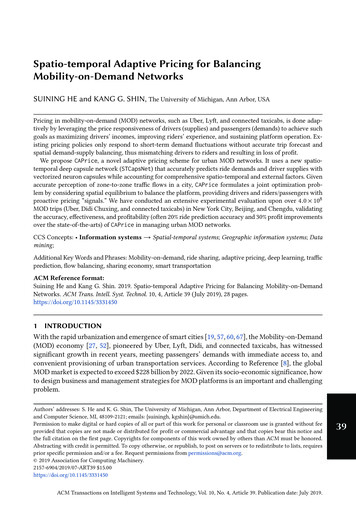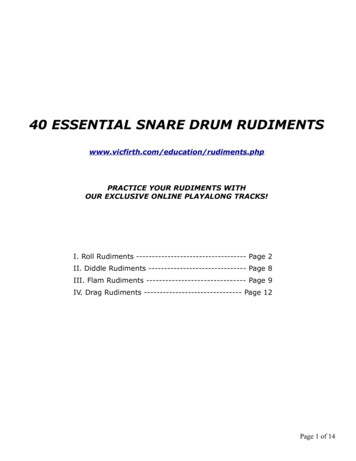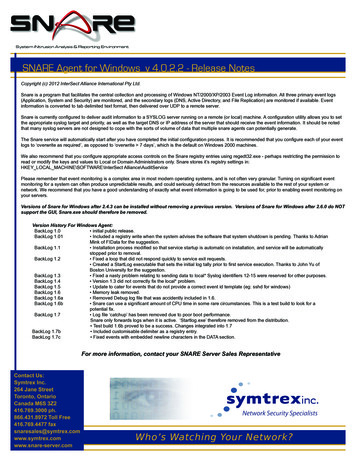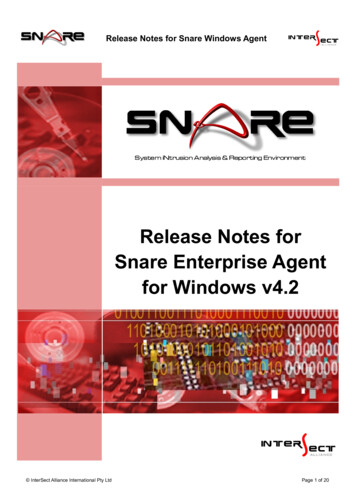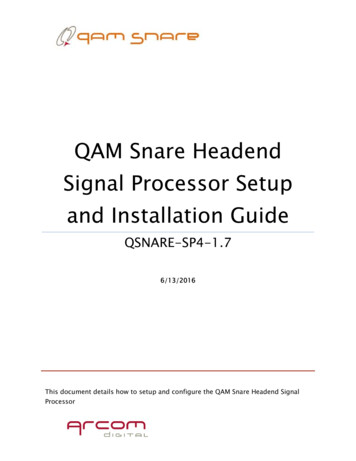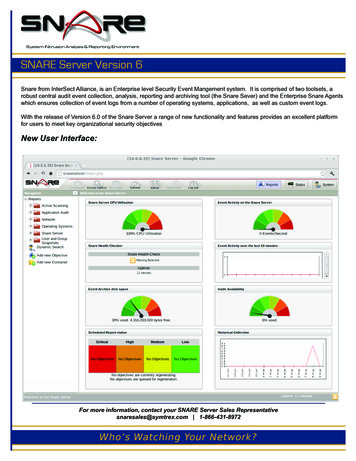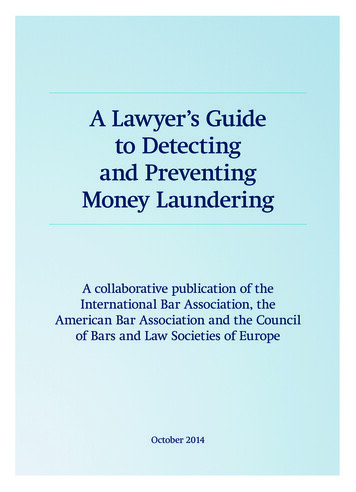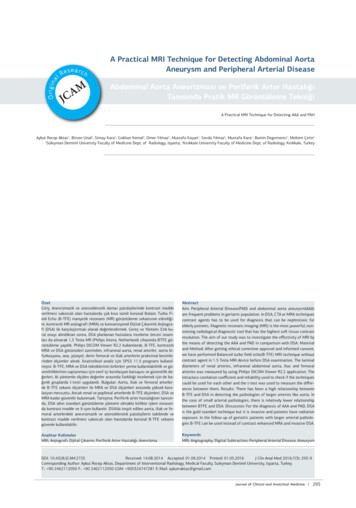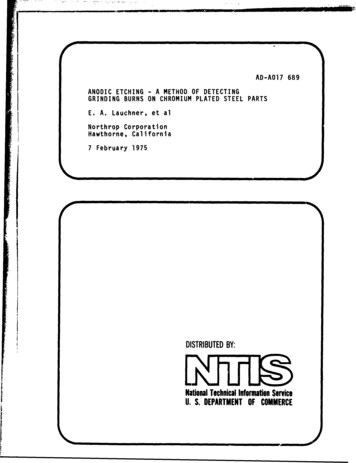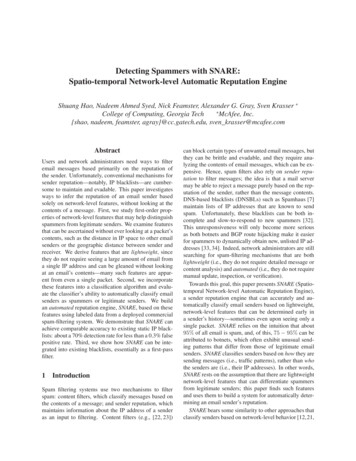
Transcription
Detecting Spammers with SNARE:Spatio-temporal Network-level Automatic Reputation EngineShuang Hao, Nadeem Ahmed Syed, Nick Feamster, Alexander G. Gray, Sven Krasser College of Computing, Georgia TechMcAfee, Inc.{shao, nadeem, feamster, agray}@cc.gatech.edu, sven krasser@mcafee.comAbstractUsers and network administrators need ways to filteremail messages based primarily on the reputation ofthe sender. Unfortunately, conventional mechanisms forsender reputation—notably, IP blacklists—are cumbersome to maintain and evadable. This paper investigatesways to infer the reputation of an email sender basedsolely on network-level features, without looking at thecontents of a message. First, we study first-order properties of network-level features that may help distinguishspammers from legitimate senders. We examine featuresthat can be ascertained without ever looking at a packet’scontents, such as the distance in IP space to other emailsenders or the geographic distance between sender andreceiver. We derive features that are lightweight, sincethey do not require seeing a large amount of email froma single IP address and can be gleaned without lookingat an email’s contents—many such features are apparent from even a single packet. Second, we incorporatethese features into a classification algorithm and evaluate the classifier’s ability to automatically classify emailsenders as spammers or legitimate senders. We buildan automated reputation engine, SNARE, based on thesefeatures using labeled data from a deployed commercialspam-filtering system. We demonstrate that SNARE canachieve comparable accuracy to existing static IP blacklists: about a 70% detection rate for less than a 0.3% falsepositive rate. Third, we show how SNARE can be integrated into existing blacklists, essentially as a first-passfilter.1 IntroductionSpam filtering systems use two mechanisms to filterspam: content filters, which classify messages based onthe contents of a message; and sender reputation, whichmaintains information about the IP address of a senderas an input to filtering. Content filters (e.g., [22, 23])can block certain types of unwanted email messages, butthey can be brittle and evadable, and they require analyzing the contents of email messages, which can be expensive. Hence, spam filters also rely on sender reputation to filter messages; the idea is that a mail servermay be able to reject a message purely based on the reputation of the sender, rather than the message contents.DNS-based blacklists (DNSBLs) such as Spamhaus [7]maintain lists of IP addresses that are known to sendspam. Unfortunately, these blacklists can be both incomplete and slow-to-respond to new spammers [32].This unresponsiveness will only become more seriousas both botnets and BGP route hijacking make it easierfor spammers to dynamically obtain new, unlisted IP addresses [33, 34]. Indeed, network administrators are stillsearching for spam-filtering mechanisms that are bothlightweight (i.e., they do not require detailed message orcontent analysis) and automated (i.e., they do not requiremanual update, inspection, or verification).Towards this goal, this paper presents SNARE (Spatiotemporal Network-level Automatic Reputation Engine),a sender reputation engine that can accurately and automatically classify email senders based on lightweight,network-level features that can be determined early ina sender’s history—sometimes even upon seeing only asingle packet. SNARE relies on the intuition that about95% of all email is spam, and, of this, 75 95% can beattributed to botnets, which often exhibit unusual sending patterns that differ from those of legitimate emailsenders. SNARE classifies senders based on how they aresending messages (i.e., traffic patterns), rather than whothe senders are (i.e., their IP addresses). In other words,SNARE rests on the assumption that there are lightweightnetwork-level features that can differentiate spammersfrom legitimate senders; this paper finds such featuresand uses them to build a system for automatically determining an email sender’s reputation.SNARE bears some similarity to other approaches thatclassify senders based on network-level behavior [12,21,
24, 27, 34], but these approaches rely on inspecting themessage contents, gathering information across a largenumber of recipients, or both. In contrast, SNARE isbased on lightweight network-level features, which couldallow it to scale better and also to operate on higher traffic rates. In addition, SNARE is more accurate than previous reputation systems that use network-level behavioralfeatures to classify senders: for example, SNARE’s falsepositive rate is an order of magnitude less than that inour previous work [34] for a similar detection rate. It isthe first reputation system that is both as accurate as existing static IP blacklists and automated to keep up withchanging sender behavior.Despite the advantages of automatically inferringsender reputation based on “network-level” features, amajor hurdle remains: We must identify which featureseffectively and efficiently distinguish spammers from legitimate senders. Given the massive space of possiblefeatures, finding a collection of features that classifiessenders with both low false positive and low false negative rates is challenging. This paper identifies thirteensuch network-level features that require varying levels ofinformation about senders’ history.Different features impose different levels of overhead.Thus, we begin by evaluating features that can be computed purely locally at the receiver, with no informationfrom other receivers, no previous sending history, andno inspection of the message itself. We found severalfeatures that fall into this category are surprisingly effective for classifying senders, including: The AS of thesender, the geographic distance between the IP address ofthe sender and that of the receiver, the density of emailsenders in the surrounding IP address space, and the timeof day the message was sent. We also looked at various aggregate statistics across messages and receivers(e.g., the mean and standard deviations of messages sentfrom a single IP address) and found that, while thesefeatures require slightly more computation and messageoverhead, they do help distinguish spammers from legitimate senders as well. After identifying these features,we analyze the relative importance of these features andincorporate them into an automated reputation engine,based on the RuleFit [19] ensemble learning algorithm.In addition to presenting the first automated classifierbased on network-level features, this paper presents several additional contributions. First, we presented a detailed study of various network-level characteristics ofboth spammers and legitimate senders, a detailed studyof how well each feature distinguishes spammers fromlegitimate senders, and explanations of why these features are likely to exhibit differences between spammersand legitimate senders. Second, we use state-of-the-artensemble learning techniques to build a classifier usingthese features. Our results show that SNARE’s perfor-mance is at least as good as static DNS-based blacklists,achieving a 70% detection rate for about a 0.2% falsepositive rate. Using features extracted from a single message and aggregates of these features provides slight improvements, and adding an AS “whitelist” of the ASesthat host the most commonly misclassified senders reduces the false positive rate to 0.14%. This accuracyis roughly equivalent to that of existing static IP blacklists like SpamHaus [7]; the advantage, however, is thatSNARE is automated, and it characterizes a sender basedon its sending behavior, rather than its IP address, whichmay change due to dynamic addressing, newly compromised hosts, or route hijacks. Although SNARE’s performance is still not perfect, we believe that the benefitsare clear: Unlike other email sender reputation systems,SNARE is both automated and lightweight enough to operate solely on network-level information. Third, we provide a deployment scenario for SNARE. Even if others donot deploy SNARE’s algorithms exactly as we have described, we believe that the collection of network-levelfeatures themselves may provide useful inputs to othercommercial and open-source spam filtering appliances.The rest of this paper is organized as follows. Section 2 presents background on existing sender reputationsystems and a possible deployment scenario for SNAREand introduces the ensemble learning algorithm. Section 3 describes the network-level behavioral propertiesof email senders and measures first-order statistics related to these features concerning both spammers andlegitimate senders. Section 4 evaluates SNARE’s performance using different feature subsets, ranging from thosethat can be determined from a single packet to those thatrequire some amount of history. We investigate the potential to incorporate the classifier into a spam-filteringsystem in Section 5. Section 6 discusses evasion andother limitations, Section 7 describes related work, andSection 8 concludes.2 BackgroundIn this section, we provide background on existing senderreputation mechanisms, present motivation for improvedsender reputation mechanisms (we survey other relatedwork in Section 7), and describe a classification algorithm called RuleFit to build the reputation engine. Wealso describe McAfee’s TrustedSource system, which isboth the source of the data used for our analysis and apossible deployment scenario for SNARE.2.1 Email Sender Reputation SystemsToday’s spam filters look up IP addresses in DNSbased blacklists (DNSBLs) to determine whether anIP address is a known source of spam at the time
of lookup. One commonly used public blacklist isSpamhaus [7]; other blacklist operators include SpamCop [6] and SORBS [5]. Current blacklists have threemain shortcomings. First, they only provide reputationat the granularity of IP addresses. Unfortunately, as ourearlier work observed [34], IP addresses of senders aredynamic: roughly 10% of spam senders on any given dayhave not been previously observed. This study also observed that many spamming IP addresses will go inactivefor several weeks, presumably until they are removedfrom IP blacklists. This dynamism makes maintainingresponsive IP blacklists a manual, tedious, and inaccurate process; they are also often coarse-grained, blacklisting entire prefixes—sometimes too aggressively—rather than individual senders. Second, IP blacklists aretypically incomplete: A previous study has noted thatas much as 20% of spam received at spam traps is notlisted in any blacklists [33]. Finally, they are sometimesinaccurate: Anecdotal evidence is rife with stories ofIP addresses of legitimate mail servers being incorrectlyblacklisted (e.g., because they were reflecting spam tomailing lists). To account for these shortcomings, commercial reputation systems typically incorporate additional data such as SMTP metadata or message fingerprints to mitigate these shortcomings [11]. Our previouswork introduced “behavioral blacklisting” and developeda spam classifier based on a single behavioral feature: thenumber of messages that a particular IP address sendsto each recipient domain [34]. This paper builds on themain theme of behavioral blacklisting by finding betterfeatures that can classify senders earlier and are more resistant to evasion.2.2 Data and Deployment ScenarioThis section describes McAfee’s TrustedSource emailsender reputation system. We describe how we use thedata from this system to study the network-level featuresof email senders and to evaluate SNARE’s classification.We also describe how SNARE’s features and classification algorithms could be incorporated into a real-timesender reputation system such as TrustedSource.Data source TrustedSource is a commercial reputationsystem that allows lookups on various Internet identifierssuch as IP addresses, URLs, domains, or message fingerprints. It receives query feedback from various different device types such as mail gateways, Web gateways,and firewalls. We evaluated SNARE using the query logsfrom McAfee’s TrustedSource system over a fourteenday period from October 22–November 4, 2007. Eachreceived email generates a lookup to the TrustedSourcedatabase, so each entry in the query log represents asingle email that was sent from some sender to one ofMcAfee’s TrustedSource appliances. Due to the volumeFieldtimestampts server namescoresource ipquery ipbody lengthcount taddrDescriptionUNIX timestampName of server that handles thequeryScore for the message based on acombination of anti-spam filtersSource IP in the packet (DNS serverrelaying the query to us)The IP being queriedLength of message bodyNumber of To-addressesFigure 1: Description of data used from the McAfeedataset.Figure 2: Distribution of senders’ IP addresses in Hilbertspace for the one-week period (October 22–28, 2007) ofour feature study. (The grey blocks are unused IP space.)of the full set of logs, we focused on logs from a single TrustedSource server, which reflects about 25 millionemail messages as received from over 1.3 million IP addresses each day. These messages were reported fromapproximately 2,500 distinct TrustedSource appliancesgeographically distributed around the world. While thereis not a precise one-to-one mapping between domainsand appliances, and we do not have a precise count forthe number of unique domains, the number of domainsis roughly of the same order of magnitude.The logs contain many fields with metadata for eachemail message; Figure 1 shows a subset of the fields thatwe ultimately use to develop and evaluate SNARE’s classification algorithms. The timestamp field reflects thetime at which the message was received at a TrustedSource appliance in some domain; the source ip fieldreflects the source IP of the machine that issued the DNSquery (i.e., the recipient of the email). The query ip
field is the IP address being queried (i.e., the IP addressof the email sender). The IP addresses of the sendersare shown in the Hilbert space, as in Figure 21 , whereeach pixel represents a /24 network prefix and the intensity indicates the observed IP density in each block. Thedistribution of the senders’ IP addresses shows that theTrustedSource database collocated a representative setof email across the Internet. We use many of the otherfeatures in Figure 1 as input to SNARE’s classificationalgorithms.To help us label senders as either spammers or legitimate senders for both our feature analysis (Section 3) andtraining (Sections 2.3 and 4), the logs also contain scoresfor each email message that indicate how McAfee scoredthe email sender based on its current system. The scorefield indicates McAfee’s sender reputation score, whichwe stratify into five labels: certain ham, likely ham, certain spam, likely ham, and uncertain. Although thesescores are not perfect ground truth, they do representthe output of both manual classification and continuallytuned algorithms that also operate on more heavy-weightfeatures (e.g., packet payloads). Our goal is to develop afully automated classifier that is as accurate as TrustedSource but (1) classifies senders automatically and (2) relies only on lightweight, evasion-resistant network-levelfeatures.Deployment and data aggregation scenario Becauseit operates only on network-level features of email messages, SNARE could be deployed either as part of TrustedSource or as a standalone DNSBL. Some of the features that SNARE uses rely on aggregating sender behavior across a wide variety of senders. To aggregate thesefeatures, a monitor could collect information about theglobal behavior of a sender across a wide variety of recipient domains. Aggregating this information is a reasonably lightweight operation: Since the features thatSNARE uses are based on simple features (i.e., the IPaddress, plus auxiliary information), they can be piggybacked in small control messages or in DNS messages(as with McAfee’s TrustedSource deployment).2.3 Supervised Learning: RuleFitEnsemble learning: RuleFit Learning ensembles havebeen among the popular predictive learning methodsover the last decade. Their structural model takes theformMXF (x) a0 am fm (x)(1)m 1Where x are input variables derived form the training data (spatio-temporal features); fm (x) are different1Alarger figure is available at ons called ensemble members (“base learner”) andM is the size of the ensemble; and F (x) is the predictiveoutput (labels for “spam” or “ham”), which takes a linear combination of ensemble members. Given the baselearners, the technique determines the parameters for thelearners by regularized linear regression with a “lasso”penalty (to penalize large coefficients am ).Friedman and Popescu proposed RuleFit [19] to construct regression and classification problems as linearcombinations of simple rules. Because the number ofbase learners in this case can be large, the authors propose using the rules in a decision tree as the base learners. Further, to improve the accuracy, the variables themselves are also included as basis functions. Moreover,fast algorithms for minimizing the loss function [18] andthe strategy to control the tree size can greatly reduce thecomputational complexity.Variable importance Another advantage of RuleFit isthe interpretation. Because of its simple form, each ruleis easy to understand. The relative importance of therespective variables can be assessed after the predictivemodel is built. Input variables that frequently appear inimportant rules or basic functions are deemed more relevant. The importance of a variable xi is given as importance of the basis functions that correspond directlyto the variable, plus the average importance of all theother rules that involve xi . The RuleFit paper has moredetails [19]. In Section 4.3, we show the relative importance of these features.Comparison to other algorithms There exist two otherclassic classifier candidates, both of which we testedon our dataset and both of which yielded poorer performance (i.e., higher false positive and lower detectionrates) than RuleFit. Support Vector Machine (SVM) [15]has been shown empirically to give good generalizationperformance on a wide variety of problems such as handwriting recognition, face detection, text categorization,etc. On the other hand, they do require significant parameter tuning before the best performance can be obtained. If the training set is large, the classifier itself cantake up a lot of storage space and classifying new datapoints will be correspondingly slower since the classification cost is O(S) for each test point, where S is thenumber of support vectors. The computational complexity of SVM conflicts with SNARE’s goal to make decisionquickly (at line rate). Decision trees [30] are another typeof popular classification method. The resulting classifieris simple to understand and faster, with the prediction ona new test point taking O(log(N )), where N is the number of nodes in the trained tree. Unfortunately, decisiontrees compromise accuracy: its high false positive ratesmake it less than ideal for our purpose.
3 Network-level FeaturesIn this section, we explore various spatio-temporal features of email senders and discuss why these propertiesare relevant and useful for differentiating spammers fromlegitimate senders. We categorize the features we analyze by increasing level of overhead: Single-packet features are those that can be determined with no previous history from the IP addressthat SNARE is trying to classify, and given only asingle packet from the IP address in question (Section 3.1). Single-header and single-message features can begleaned from a single SMTP message header oremail message (Section 3.2). Aggregate features can be computed with varyingamounts of history (i.e., aggregates of other features) (Section 3.3).E
from McAfee’s TrustedSource system over a fourteen-day period from October 22–November 4, 2007. Each received email generates a lookup to the TrustedSource database, so each entry in the query log represents a single email that was sent from some sender to one of McAfee’s Trus
